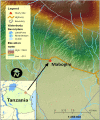Social economic factors and malaria transmission in Lower Moshi, northern Tanzania
- PMID: 22741551
- PMCID: PMC3425329
- DOI: 10.1186/1756-3305-5-129
Social economic factors and malaria transmission in Lower Moshi, northern Tanzania
Abstract
Background: For many years social economic status has been used as an indicator to characterize malaria treatment seeking behaviors of communities and their adherence to malaria control programs. The present study was therefore conducted to assess the influence of household social economic status, knowledge, attitude and practice on treatment seeking behaviors, distance to health facilities and vector control measures in the Lower Moshi area, northern Tanzania.
Methods: A cross-sectional household survey was carried out, a quantitative method was used to collect information from the households, and the household socio-economic status was estimated by employing a household asset-based approach. The structured questionnaire also collected information on malaria knowledge, attitudes and treatment seeking behaviors.
Results: A total of 197 (68.8% were female) household heads were interviewed. Distance to the health centers influenced malaria treatment seeking behaviors especially for children (P = 0.001) and the number of visits to the health facilities made by the household members (P = 0.001). The head of the households' level of education had an influence on bed-net retreatment (P < 0.001) and acceptability of larval control programmes (P <0.001). Similarly, a significant association was observed between bed-net retreatment, larval control and occupation of the head of the household .
Conclusion: Distance to the health centre influenced malaria treatment seeking behaviors, and the number of visits made by the household members. In addition, the education level of the household heads played a role in understanding and in the selection of malaria interventions for the households. Increasing the number of health facilities close to rural areas will improve malaria treatment seeking behavior, case management and hence reduce malaria-associated morbidities, especially in high risk groups.
Figures



Similar articles
-
Assessment of community knowledge, practice, and determinants of malaria case households in the rural area of Raya Azebo district, Northern Ethiopia, 2017.PLoS One. 2019 Oct 15;14(10):e0222427. doi: 10.1371/journal.pone.0222427. eCollection 2019. PLoS One. 2019. PMID: 31613893 Free PMC article.
-
Socio-demographic factors influencing knowledge, attitude and practice (KAP) regarding malaria in Bangladesh.BMC Public Health. 2012 Dec 18;12:1084. doi: 10.1186/1471-2458-12-1084. BMC Public Health. 2012. PMID: 23253186 Free PMC article.
-
Determination of the predictive factors of long-lasting insecticide-treated net ownership and utilisation in the Bamenda Health District of Cameroon.BMC Public Health. 2017 Mar 16;17(1):263. doi: 10.1186/s12889-017-4155-5. BMC Public Health. 2017. PMID: 28302093 Free PMC article.
-
Malaria entomological profile in Tanzania from 1950 to 2010: a review of mosquito distribution, vectorial capacity and insecticide resistance.Tanzan J Health Res. 2011 Dec;13(5 Suppl 1):319-31. Tanzan J Health Res. 2011. PMID: 26591987 Review.
-
Current vector control challenges in the fight against malaria.Acta Trop. 2017 Oct;174:91-96. doi: 10.1016/j.actatropica.2017.06.028. Epub 2017 Jul 3. Acta Trop. 2017. PMID: 28684267 Review.
Cited by
-
Caregivers' treatment-seeking behaviour for children under age five in malaria-endemic areas of rural Myanmar: a cross-sectional study.Malar J. 2015 Jan 5;14:1. doi: 10.1186/1475-2875-14-1. Malar J. 2015. PMID: 25557741 Free PMC article.
-
An application of cultural model to assess and compare malaria prevention among Afghani migrant and Baluchi resident in the endemic area, southeastern Iran.J Immigr Minor Health. 2014 Feb;16(1):102-10. doi: 10.1007/s10903-013-9850-4. J Immigr Minor Health. 2014. PMID: 23775110
-
Socio-economic determinants for malaria transmission risk in an endemic primary health centre in Assam, India.Infect Dis Poverty. 2014 Jun 24;3:19. doi: 10.1186/2049-9957-3-19. eCollection 2014. Infect Dis Poverty. 2014. PMID: 24991410 Free PMC article.
-
Novel Indoor Residual Spray Insecticide With Extended Mortality Effect: A Case of SumiShield 50WG Against Wild Resistant Populations of Anopheles arabiensis in Northern Tanzania.Glob Health Sci Pract. 2018 Dec 27;6(4):758-765. doi: 10.9745/GHSP-D-18-00213. Print 2018 Dec 27. Glob Health Sci Pract. 2018. PMID: 30591581 Free PMC article.
-
The independent effect of living in malaria hotspots on future malaria infection: an observational study from Misungwi, Tanzania.Malar J. 2014 Nov 21;13:445. doi: 10.1186/1475-2875-13-445. Malar J. 2014. PMID: 25413016 Free PMC article.
References
-
- Ministry of Health and Social Welfare. National malaria control medium term malaria strategic plan, February 2008 – January 2013. Dar Es Salaam, Tanzania; 2008.
-
- Ministry of Health. National Malaria Medium-term Strategic Plan, July 2002–June 2006. Dar Es Salaam, Tanzania; 2002.
Publication types
MeSH terms
LinkOut - more resources
Full Text Sources
Medical

